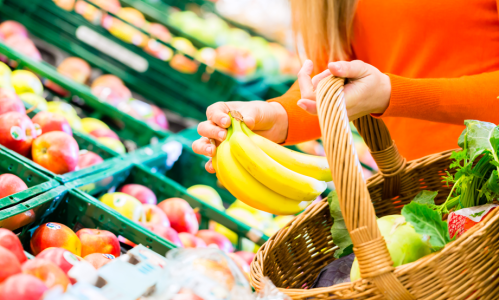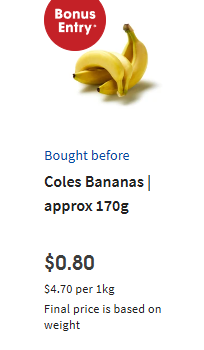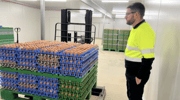Discover 'sneaky tactic' Woolworths uses on online orders that's raising eyebrows
By
- Replies 19
As shoppers, we're always on the lookout for the best deals and ways to stretch our hard-earned dollars, especially in today's economy, where every cent counts.
But have you ever wondered if the convenience of online shopping could be costing you more than you bargained for?
Some Woolworths customers have raised concerns over what they perceive as a 'sneaky tactic' in pricing fresh produce in online orders.
The issue is the difference in how items are priced online versus in-store.
Traditionally, when we stroll through the aisles of our local supermarket, we're used to seeing fresh produce like bananas priced by weight.
This makes sense, as it accounts for the natural variation in size and ensures we pay for exactly what we get.
However, the online shopping experience seems to be a different basket of fruit altogether.
One Woolworths shopper, who admits to doing 'quite a lot of online shopping,' has pointed out that bananas and other fresh produce are often priced per item online, rather than by weight.
‘I’ve always noticed that in-store fresh produce is generally priced per kg or gram. Online is the opposite, where it’s all priced per item,’
‘I’ve never thought of it before but wondered if anyone has done some work to see if you do pay more overall for the privilege of online shopping.’
‘I understand from a picking and logistics point of view it’s easier to grab five bananas instead of weight of 1.2kgs or whatever, but I was also thinking if this was a sneaky way of intentionally bumping up margins.’
This means that regardless of whether you receive a bunch of petite bananas or a cluster of hefty ones, the price remains the same – 77 cents each, in the case of bananas.
This has led to speculation that customers might pay more for online convenience.
The shopper noted that while their local store prices bananas at around $4 per kilo, the cost online is per banana, without consideration for size.
Woolworths has responded to these concerns, explaining that they've found that online customers prefer to order an exact number of pieces for certain types of produce.
‘For certain varieties of produce, we know online customers are looking to order an exact number of pieces, so we provide prices per piece to make their shop easier.’ a Woolworths spokesperson explained.
‘Our online prices for individual pieces of fruit and vegetables are calculated using the same price we offer in-store,’
‘We’re focused on providing value and convenience for our customers, however they choose to shop with us.’
But Woolworths isn't alone in this practice. Other supermarkets like Coles and Harris Farm also use a per-item pricing model for their online stores.
Moreover, Woolworths shoppers have reported paying higher prices when using the Woolworths-owned app MILKRUN, a delivery service offering over 10,000 products.
One customer noticed a laundry product priced at $7.40 on the app while the same item was available in-store for $4.50 – a significant 64 per cent increase.
In related news, a Woolworths shopper revealed a trick to find current discount codes.
Visit the Woolworths Facebook page, then check 'Page Transparency' and 'Ad Library' to discover ads with discount codes. Read more about it here.
 Have you noticed a difference in pricing? Do you feel you're getting value for money? Share your stories and tips in the comments below.
Have you noticed a difference in pricing? Do you feel you're getting value for money? Share your stories and tips in the comments below.
But have you ever wondered if the convenience of online shopping could be costing you more than you bargained for?
Some Woolworths customers have raised concerns over what they perceive as a 'sneaky tactic' in pricing fresh produce in online orders.
The issue is the difference in how items are priced online versus in-store.
Traditionally, when we stroll through the aisles of our local supermarket, we're used to seeing fresh produce like bananas priced by weight.
This makes sense, as it accounts for the natural variation in size and ensures we pay for exactly what we get.
However, the online shopping experience seems to be a different basket of fruit altogether.
One Woolworths shopper, who admits to doing 'quite a lot of online shopping,' has pointed out that bananas and other fresh produce are often priced per item online, rather than by weight.
‘I’ve always noticed that in-store fresh produce is generally priced per kg or gram. Online is the opposite, where it’s all priced per item,’
‘I’ve never thought of it before but wondered if anyone has done some work to see if you do pay more overall for the privilege of online shopping.’
‘I understand from a picking and logistics point of view it’s easier to grab five bananas instead of weight of 1.2kgs or whatever, but I was also thinking if this was a sneaky way of intentionally bumping up margins.’
This means that regardless of whether you receive a bunch of petite bananas or a cluster of hefty ones, the price remains the same – 77 cents each, in the case of bananas.
This has led to speculation that customers might pay more for online convenience.
The shopper noted that while their local store prices bananas at around $4 per kilo, the cost online is per banana, without consideration for size.
Woolworths has responded to these concerns, explaining that they've found that online customers prefer to order an exact number of pieces for certain types of produce.
‘For certain varieties of produce, we know online customers are looking to order an exact number of pieces, so we provide prices per piece to make their shop easier.’ a Woolworths spokesperson explained.
‘Our online prices for individual pieces of fruit and vegetables are calculated using the same price we offer in-store,’
‘We’re focused on providing value and convenience for our customers, however they choose to shop with us.’
But Woolworths isn't alone in this practice. Other supermarkets like Coles and Harris Farm also use a per-item pricing model for their online stores.
Moreover, Woolworths shoppers have reported paying higher prices when using the Woolworths-owned app MILKRUN, a delivery service offering over 10,000 products.
One customer noticed a laundry product priced at $7.40 on the app while the same item was available in-store for $4.50 – a significant 64 per cent increase.
In related news, a Woolworths shopper revealed a trick to find current discount codes.
Visit the Woolworths Facebook page, then check 'Page Transparency' and 'Ad Library' to discover ads with discount codes. Read more about it here.
Key Takeaways
- Some Woolworths shoppers have noted a difference in pricing models when shopping online versus in-store, with products being priced per item online compared to by weight in-store.
- A shopper observed that bananas are sold at a fixed price per piece online, irrespective of their size, which may lead to paying more than the per-kilo price in-store.
- A Woolworths spokesperson explained that in-store per-kilogram pricing is based on average weights, which are regularly checked to reflect seasonal variations and calculated online prices per piece.
- There have been reports of customers experiencing higher prices when shopping through the Woolworths-owned app MILKRUN compared to in-store prices.










